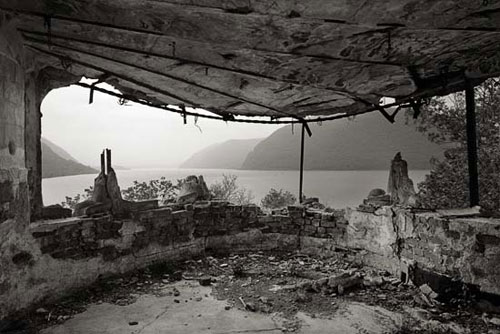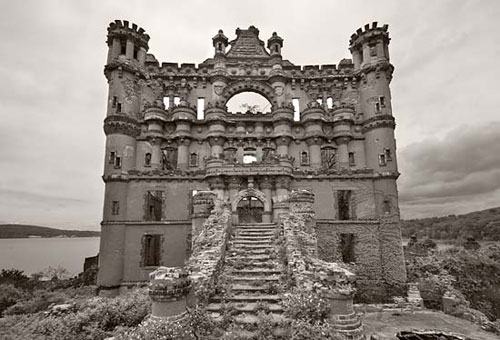
Beacon, NY—Just south of the Newburgh-Beacon Bridge lays a
mysteriously isolated island and on this island stands the ruin of a
once grand Scottish Castle, which in its time, stood as a fortress and
rose above the trees to create an impressive gateway to the Hudson
Highlands. This is the image I remember as I child, and I am still
captivated by the menacing vision of this dark lifeless structure
surrounded by the rushing tides of the Hudson River. Today this majestic
ruin, known as Bannerman’s Island Arsenal, rests on Pollepel
Island and crumbles before our eyes. The recent deterioration of
the ruin inspired me to not only witness and photograph the devastation,
but to write about its lingering legends.

Pollepel Island was just as mystifying nearly 400 years ago as it is
today. This dark deserted isle was the subject of an impressive
“arsenal” of storytellers’ tales. Storytelling was a common past time
and, just as with any story, over time these tales were naturally
embellished and grew into astounding historical accounts that were
passed down by the area’s early inhabitants giving us the great early
legends of angry spirits, lost lovers, and ghostly goblins.
The Early LegendsLong before Francis Bannerman built his castle, this six and
three quarter acre isle was uninhabited. The Native Americans feared the
island was possessed by evil spirits, which made it a prime location
for settlers to hide during periods of aggression with the Indians.
Over time, a number of legendary tales evolved. As I walked along the
shoreline, the crystalline ice formations glistened in the sun and I
thought of the legend of Polly Pell, a story that stakes claim for
naming the island. The story of Polly Pell (Pollepel) was shared among

Dutch settlers when newlywed Polly Pell was saved from the frozen Hudson
River following a romantic sleigh ride with her beau. The fierce
currents of the icy Hudson washed Polly and her new husband up on the
rocky shores when a slave rescued them and named the island after her
and the legend of Polly Pell was born.
The infamous Pollepel Island became well-known among Hudson River
sailors. The secluded island was the basis of much of fantastical
folklore that surrounds river travel through the Hudson Highlands.
The story The Storm-Ship written by famed storyteller and
Tarrytown resident Washington Irving, tells the tale of a dreaded tribe
of goblins that the Dutch feared inhabited Pollepel Island. These
goblins thrived under the reign of the Heer of Dunderburgh who is said
to control the gusty winds and treacherous waters of the Highlands. The
Dutch lived in fear of the Dunderburgh. The “storm ship”’ actually
refers to the legendary Flying Dutchman, a ship lost in a brutal storm
sinking just south of Pollepel Island. The story condemns the captain
and his crew to sailing the Hudson for eternity and it has been reported
that their cries for help can be heard during violent storms. Once a
ship ventured past Pollepel Island, the captain and crew earned right of
passage for a safe journey down the Hudson.
Whether or not the ghosts, goblins, and evil spirits existed was left
to the imagination. However, boat captains were known to cast off new
sailors on their inaugural voyages down the river as an initiation.
Often drunk and scared out of their wits these poor sailors were forced
to disembark to take their chances with the phantoms of Pollepel Island.
They were picked up on the return trip hopefully sobered up and

fearless.
Given the history of Pollepel’s influence on shipmen of that period,
it is ironic that the next ghost story would be that of a tugboat
captain angered by Bannerman himself.
A Ghost from the Bannerman EraFrancis Bannerman VI was the visionary behind the progressive growth
of the Scottish castle that bears the name of Bannerman’s Island
Arsenal. Bannerman purchased Pollepel Island in 1900 when his
insatiable hobby of scrap collecting gave way to becoming a massive arms
company. As his wealth increased, Bannerman was able to build a home
that would serve as a monument to his heritage. The castle itself was
comprised of six major sections; three arsenals, the lodge, the tower,
and the superintendent’s house. In addition, there is also a family
residence with magnificent views of the Highlands.
The property was protected by breakwaters, which were formed by the
sinking of old barges and boats. There is a legendary tale that the
tugboat captain of one of the boats requested that his prized vessel not
be sunk in his presence, but before anyone knew it, the boat was
sinking right before the former captains eyes. The captain cursed
Bannerman and swore revenge. It has been said that employees in the
lodge often heard the ringing of the boat’s bell at various times

signifying that the captain had returned to make good on his promise.
Just as the tugboat captain experienced a devastating loss that would
condemn him to Bannerman’s castle for an eternity, Bannerman would also
experience loss.
A Castle in Ruin
Bannerman’s Island Arsenal has had its share of disastrous events. A
1920 explosion of gun powder and shells blew a wall clear over to the
mainland. Three people were injured including Mrs. Bannerman and the
incident incurred $50,000 in damage. The most devastating event occurred
in August of 1969 in a fire that gutted all the buildings on the
island. It was undetermined as to what was the cause of the engulfing
blaze that would destroy the celebrated estate of the late Francis
Bannerman VI leaving it in ruin. This would not be the last disastrous
event that the castle would endure. In late 2009 and early 2010 the
castle saw increased damage that has forever changed the landscape of
this iconic structure. I wonder how much longer it will endure the
elements and how this rich haunted history will be remembered.
Remembering Bannerman’s Island ArsenalThe recent collapses have removed Bannerman’s name from his cherished
castle. As the castle fades into history, the legends will remain to
haunt us for a lifetime. As unbelievable as the stories may be, they add
to the allure of the island and someday may be all that remains of one
of the most captivating historical sites in the Hudson Valley. I think
that Jane Bannerman’s quote best describes how I feel about Polly Pell’s
island.
“No one can tell what associations and incidents will involve the island in the future. Time, the elements, and maybe even the goblins of the island will take their toll of some of the turrets and towers, and perhaps eventually the castle itself, but the little island will always have it’s place in history and in legend and will be forever a jewel in it’s Hudson Highland setting.”- Jane Bannerman
Island Tours and ContributionsThe island and castle is easily viewed from land. Take a short drive
south on Route 9D until you get to Breakneck Ridge. Park on the side of
the road and cross the bridge over the trains track. BE VERY CAREFUL OF
PASSING TRAINS!!
 Beacon, NY—Just south of the Newburgh-Beacon Bridge lays a
Beacon, NY—Just south of the Newburgh-Beacon Bridge lays a
 Dutch settlers when newlywed Polly Pell was saved from the frozen Hudson
Dutch settlers when newlywed Polly Pell was saved from the frozen Hudson fearless.
fearless. signifying that the captain had returned to make good on his promise.
signifying that the captain had returned to make good on his promise. Bannerman’s Island Arsenal has had its share of disastrous events. A
Bannerman’s Island Arsenal has had its share of disastrous events. A






















